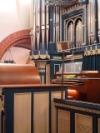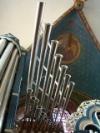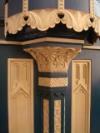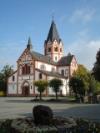Complete description of the selected organ
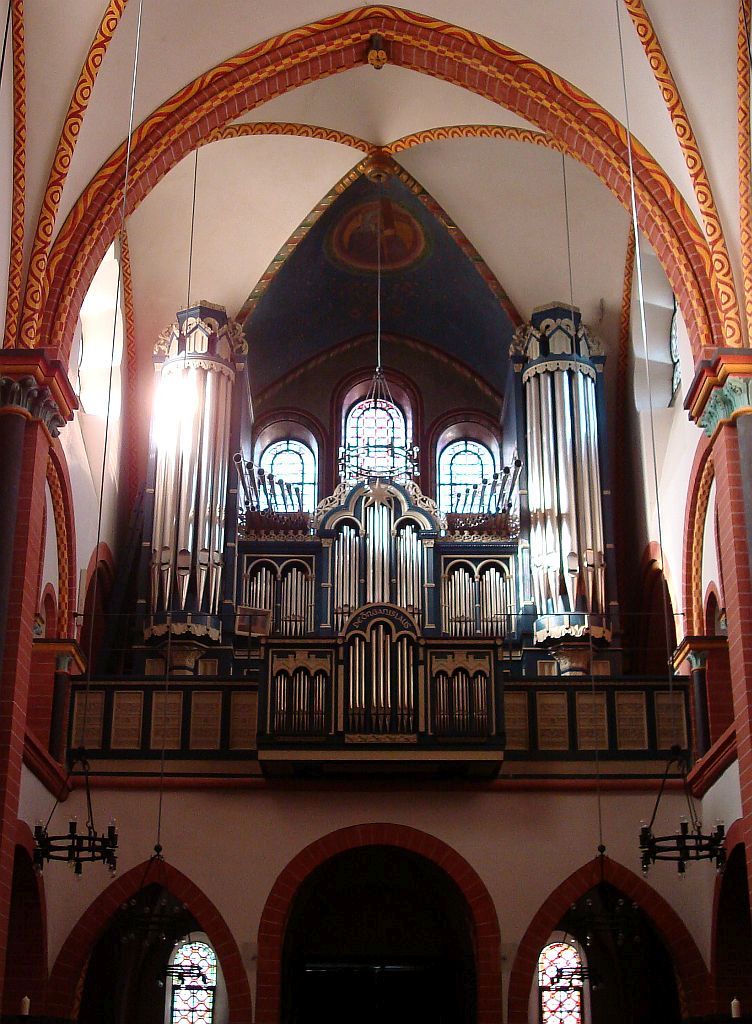
Photo: Tjalling Roosjen
Sinzig am Rhein, Deutschland (Rheinland-Pfalz) - Katholische Pfarrkirche Sankt Peter
Municipal: Sinzig am Rhein
Address: Zehnthofstraße 11, 53489, Sinzig am Rhein
Website: http://www.kath-kirche-sinzig.org/
Description nr.: 2000643.
Built by: E.F. Walcker & Cie. (1972) - opus 5295
The organ contains older material: from 1880 by H.W. Breidenfeld & Söhne
Technical data
Specification
Hauptwerk (C-c''''): Pommer 16', Hohlpfeife 8', Spillpfeife 8', Principal 8', Octave 4', Spitzgambe 4', Nasard 2 2/3', Schweitzerpfeife 2', Mollterz 16/19', Oberton 2-4 fach (3 1/5'), Mixtur 5 fach (2'), Cymbel 5 fach (1/4'), Französische Krummhorn 16', Trompete 8', Röhrenglockenton 8' (C-f') - tubular bells, Harfe (fis'-c'''') - metal bars.
Rückpositiv (C-c''''): Quintade 8', Stillgedackt 8', Principal 4', Flauto Dolce 4', Nachthorn 2', Quinte 1 1/3', Fünfzehnte 8/15', Scharff 4 fach (1'), Dulzianregal 8', Xylophon 4', Tremulant.
Brustwerk (Schwellbar) (C-c''''): Holzgedackt 8', Rohrflöte 4', Principal 2', Terz 1 3/5', Blockflöte 1', Oberton 2 fach (1 1/7'), Cymbel 2 fach (1/2'), Harfenregal 16', Schalmey 4', Tremolo - adjustable speed, Psalterium (C-c'''').
Trompeteria (1992, no longer present) (C-c''''): Mixtur 5-8 fach (1 1/3'), Trompeta Magna 16' - en chamade, Trompeta de Batalla 8' - en chamade, Clarín Brillante 4' - en chamade.
Pedal (C-g'): Subbaß 16', Principal 16', Octavbaß 8', Violoncello 8', Quintgedackt 5 1/3', Octave 4', Gemshorn 2', Hintersatz 3 fach (2'), Theorbe 3 fach (6 2/5'), Dulcian 32', Bombarde 16', Fagott 8', Trompetenregal 4'.
Other stops: Cymbelstern, Percussion.
Couplers: Hauptwerk - Rückpositiv, Hauptwerk - Brustwerk, Rückpositiv - Brustwerk, Pedal - Hauptwerk, Pedal - Rückpositiv, Pedal - Brustwerk.
Accessories: 3 freie Kombinationen, Tastenfessel, Registermanual, Mixturensetzer, Tutti, Windrossel (Hauptwerk en Brustwerk).
YouTube
Wie Verrückt Ist Diese Orgel? / Fraser Gartshore (2019)

Photo: Tjalling Roosjen
Sinzig am Rhein, Deutschland (Rheinland-Pfalz) - Katholische Pfarrkirche Sankt Peter
Municipal: Sinzig am Rhein
Address: Zehnthofstraße 11, 53489, Sinzig am Rhein
Website: http://www.kath-kirche-sinzig.org/
Description nr.: 2000643.
Built by: E.F. Walcker & Cie. (1972) - opus 5295
The organ contains older material: from 1880 by H.W. Breidenfeld & Söhne
| Year | Builder | Opus | Activity | 1880 | H.W. Breidenfeld & Söhne | new organ | 1972 | E.F. Walcker & Cie. | 5295 | new organ in old case | 1979 | E.F. Walcker & Cie. | enlargement | 2019 | Klais Orgelbau | restoration |
- In 1880, the company Gebrüder Breidenfeld from Trier built a new organ in romantic style for the church of Sankt Peter in Sinzig am Rhein. The company Walcker built a new organ in 1971-1972, using parts of the Breidenfeld instrument.
- The Walcker organ in Sinzig am Rhein is a curious attempt to create a modern organ with its own twentieth century sound. The stop list was designed by Peter Bares, then Church organist. Striking are the many strange mixtures, such as the Oberton of the Hauptwerk, composed of thirds, quints, octaves and sevenths. The Cymbel also has a remarkable composition. The register Rohrenglockenton is a Carillon consisting of metal bars. The Psalterium consists of brass plates that are struck with electrically driven hammers. Another percussion instrument is the xylophone. The speed of the tremulant is adjustable, and there is also a drumset with adjustable rhythm. The organ was inaugurated on June 25, 1972.
- In 1979 the organ was expanded with a Trompeteria, which is located on a gallery on the south side. It was playable from the third manual or from a local keyboard. This Trompeteria was owned by Peter Bares. In 1992 Bares became organist of the Sankt Peterkirche in Cologne. He took the Trompetaria with him.
- The company Klais overhauled and restored the organ in Spring 2019. There were no modifications to the sound or stop list done.
Technical data
| Number of stops per division | |
| - Hauptwerk | 16 |
| - Rückpositiv | 10 |
| - Brustwerk | 10 |
| - Trompeteria | 4 |
| - Pedal | 13 |
| Total number of stops | 53 |
| Key action | Mechanical |
| Stop action | Electrical |
| Windchest(s) | Slider chests |
Specification
Hauptwerk (C-c''''): Pommer 16', Hohlpfeife 8', Spillpfeife 8', Principal 8', Octave 4', Spitzgambe 4', Nasard 2 2/3', Schweitzerpfeife 2', Mollterz 16/19', Oberton 2-4 fach (3 1/5'), Mixtur 5 fach (2'), Cymbel 5 fach (1/4'), Französische Krummhorn 16', Trompete 8', Röhrenglockenton 8' (C-f') - tubular bells, Harfe (fis'-c'''') - metal bars.
Rückpositiv (C-c''''): Quintade 8', Stillgedackt 8', Principal 4', Flauto Dolce 4', Nachthorn 2', Quinte 1 1/3', Fünfzehnte 8/15', Scharff 4 fach (1'), Dulzianregal 8', Xylophon 4', Tremulant.
Brustwerk (Schwellbar) (C-c''''): Holzgedackt 8', Rohrflöte 4', Principal 2', Terz 1 3/5', Blockflöte 1', Oberton 2 fach (1 1/7'), Cymbel 2 fach (1/2'), Harfenregal 16', Schalmey 4', Tremolo - adjustable speed, Psalterium (C-c'''').
Trompeteria (1992, no longer present) (C-c''''): Mixtur 5-8 fach (1 1/3'), Trompeta Magna 16' - en chamade, Trompeta de Batalla 8' - en chamade, Clarín Brillante 4' - en chamade.
Pedal (C-g'): Subbaß 16', Principal 16', Octavbaß 8', Violoncello 8', Quintgedackt 5 1/3', Octave 4', Gemshorn 2', Hintersatz 3 fach (2'), Theorbe 3 fach (6 2/5'), Dulcian 32', Bombarde 16', Fagott 8', Trompetenregal 4'.
Other stops: Cymbelstern, Percussion.
Couplers: Hauptwerk - Rückpositiv, Hauptwerk - Brustwerk, Rückpositiv - Brustwerk, Pedal - Hauptwerk, Pedal - Rückpositiv, Pedal - Brustwerk.
Accessories: 3 freie Kombinationen, Tastenfessel, Registermanual, Mixturensetzer, Tutti, Windrossel (Hauptwerk en Brustwerk).
| Compound stop | Composition |
| Mixtur 5 fach (Hauptwerk) | C: 2' - 1 1/3' - 1' - 2/3' - 1/2'. G: 2' - 1 1/3' - 1' - 1' - 2/3'. d°: 2 2/3' - 2' - 1 1/3' - 1' - 2/3'. a°: 2 2/3' - 2' - 2' - 1 1/3' - 1'. e': 4' - 2 2/3' - 2' - 1 1/3' - 1'. b': 4' - 2 2/3' - 2' - 2' - 1 1/3'. fis'': 8' - 4' - 2 2/3' - 2' - 1 1/3'. d''': 8' - 4' - 2 2/3' - 2 2/3' - 2'. |
| Cymbel 5 fach (Hauptwerk) | C: 1/4' - 4/21' - 2/13' - 2/17' - 1/10'. F: 1/4' - 4/17' - 1/5' - 4/21' - 2/13'. c°: 1/2' - 8/21' - 4/13' - 4/17' - 2/10'. f°: 1/2' - 8/17' - 2/5' - 8/21' - 4/13'. c': 1' - 16/21' - 8/13' - 8/17' - 2/5'. f': 1' - 16/17' - 4/5' - 16/21' - 8/13'. c'': 2' - 1 11/21' - 1 3/13' - 16/17' - 4/5'. f'': 2' - 1 15/17', 1 3/5' - 1 11/21' - 1 3/13'. c''': 4' - 3 1/21' - 2 6/13' - 1 15/17' - 1 3/5'. f''': 4' - 3 13/17' - 3 1/5' - 3 1/21' - 2 6/13'. |
| Oberton 2-4 fach (Hauptwerk) | C: 3 1/5' - 1'. G: 3 1/5' - 1 7/9' - 1'. c°: 5 1/3' - 3 1/5' - 1 7/9' - 1'. |
| Scharff 4 fach (Rückpositiv) | C: 1' - 2/3' - 1/2' - 1/3'. Bes°: 1 1/3' - 1' - 2/3' - 1/2'. gìs°: 2' - 1 1/3' - 1' - 2/3'. fis': 2 2/3' - 2' - 1 1/3' - 1'. e'': 4' - 2 2/3' - 2' - 1 1/3'. d''': 4' - 2 2/3' - 2' - 2'. |
| Cymbel 4 fach (Brustwerk) | C: 1/2' - 1/3' - 1/4' - 1/6'. Gìs°: 2/3' - 1/2' - 1/3' - 1/4'. e°: 1' - 2/3' - 1/2' - 1/3'. cis': 1 1/3' - 1' - 2/3' - 1/2'. b': 2' - 1 1/3' - 1' - 2/3'. g'': 2 2/3' - 2' - 1 1/3' - 1'. e''': 4' - 2 2/3' - 2' - 1 1/3'. |
| Oberton 2 fach (Brustwerk) | C: 1 1/7' - 8/11'. g'': 1 5/11' - 1 1/7'. d''': 2 2/7' - 1 5/11'. g''': 2 10/11' - 2 2/7'. |
| Mixtur 5-8 fach (Trompeteria) | C: 2 2/3' - 2' - 1 1/3' - 1 1/7' - 4/5'. A: 4' - 2 2/3' - 2' - 1 1/3' - 1 1/7' - 4/5'. fìs°: 4' - 2 2/3' - 2' - 1 3/5' - 1 1/3' - 1 1/7'. cis': 5 1/3' - 4' - 2 2/3' - 2' - 1 3/5' - 1 1/7'. gis': 8' - 5 1/3' - 4' - 2 2/3' - 2' - 1 3/5' - 1 1/7'. dis'': 8' - 8' - 5 1/3' - 4' - 2 2/3' - 2 2/7' - 1 3/5' - 1 1/3'. a''': 8' - 8' - 5 1/3' - 4' - 4' - 2 2/3' - 2 2/7' - 1 3/5'. |
| Hintersatz 3 fach (Pedal) | C: 2' - 1 1/3' - 1'. |
| Theorbe 3 fach (Pedal) | C: 6 2/5' - 4 4/7' - 2 2/3'. |
| Literature |
|
| Links |
https://orgelbau-klais.com/m.php?sid=492 |




